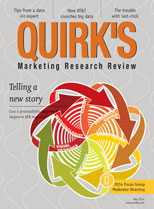Editor's note: Rajan Sambandam is chief research officer at TRC Market Research, Fort Washington, Pa. This article is an edited version of a blog post that originally appeared here under the title "How Apple, Samsung and conjoint came together."
You may have heard about the spat between Apple and Samsung. Apple is suing Samsung for alleged patent infringements that relate to features of the iPhone and iPad. The damages claimed by Apple? North of $2 billion. The obvious question is, how did Apple come up with those numbers? The non-obvious answer is, partly by using conjoint analysis - the tried-and-tested approach often used for product development work at our firm and many others.
Apple hired John Hauser, professor of marketing at MIT's Sloan School of Management, to conduct the research. Hauser is a very well-known expert in the area of product management. He has mentored and coauthored several conjoint related articles with my colleague Olivier Toubia at Columbia University. For this case, Hauser conducted two online studies (n=507 for phones and n=459 for tablets) to establish that consumers indeed valued the features that Apple was arguing about. Details about the conjoint studies are hard to get, but it appears that he has used Sawtooth Software and used the advanced statistical estimation procedure known as hierarchical Bayes (HB) to get the best-possible results. It also appears that he may have run a conjoint with seven features, incorporating graphical representations to enhance respondent understanding.
There are several lessons to be learned here for those interested in conducting a conjoint study. First, conjoint sample sizes do not have to be huge. I suspect they are larger than absolutely necessary here because the studies are being used in litigation. Second, he has wisely confined the studies to just seven attributes. We repeatedly recommend to clients that conjoint studies should not be overloaded with attributes. Conjoint tasks can be taxing for survey respondents and the more difficult they are, the less attention will be paid. Third, he is using HB estimation to obtain preferences at the individual level, which is the state-of-the-science approach. Last, he is incorporating graphics wherever possible to ensure that respondents clearly understand the features. When designing conjoint studies it is good to take these (and other) lessons into consideration to ensure that we get robust results.
So, what was the outcome? As a result of the conjoint study, Hauser was able to determine that consumers would be willing to spend an additional $32 to $102 for features like sliding to unlock, universal search and automatic word correction. Under cross-examination he acknowledged that this was stated preference in a survey and not necessarily what Apple could charge in a competitive marketplace. This is another point that we often make to clients both in conjoint and other contexts: There is a big difference between answering a survey and actual real-world behavior (where several other factors come into play). While survey results (including conjoint) can be very good comparatively, they may not be especially good absolutely. Apple used the help of another MIT-trained economist to bring in outside information and finally ended up with a damage estimate of slightly more than $2 billion.
But that is not where our story ends. Samsung decided to bring in its own marketing expert and in this case it is Professor David Reibstein from Wharton. I have met him on one of my guest lecture visits there and he is a renowned marketing expert. Reibstein questioned the research conducted by Hauser but not on any arcane technical grounds. His contention was that the research was flawed because it did not include certain important attributes such as brand name, operating system, battery life, etc. He memorably said that not including these fundamental features is like doing research "on cup holders in cars while ignoring the manufacturer name."
A good point, one which raises another issue related to conjoint design: If we are to include only a few attributes, how do we select which ones to include? While the answer may vary from case to case, in general, we recommend that we look closely at prior research. We want to identify those attributes that are important to consumers and that they would be willing to make trade-offs on.
So why would Hauser not have included some important features? I can think of at least a couple of reasons. The first is what I would call "the Apple problem." Since Apple products have their own operating system (iOS as opposed to Android), it is hard to do a conjoint with them (since it makes no sense to have combinations such as Apple-Android or Samsung-iOS). Restrictions need to be imposed, which can lead to other problems. One has to look at it case by case but clearly the decision was made here to avoid the problem entirely. But what about features like battery life? Given the needs of the litigation, and in order to keep the conjoint from becoming overly complex, I suspect they made the trade-off to just focus on the patented features in question. This opens them up for criticism but also illustrates that in practical conjoint studies, trade-offs in feature choices are sometimes inevitable if we are to get robust information from respondents.
As of this writing, the case has not yet been decided. But it has certainly been interesting to follow for researchers, as it has trained the spotlight on techniques and issues that we wrestle with every day.
